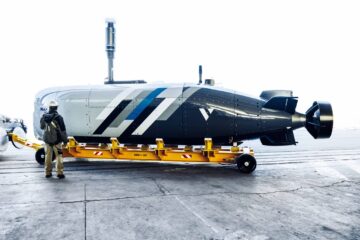The U.S. Navy is trying to deploy five large, robotic submarines to do the dangerous job of laying undersea mines. But the effort is more than 3 years behind schedule and has exceeded costs by at least $242 million.
What GAO Found
The Navy is attempting to rapidly deliver five Extra Large Unmanned Undersea Vehicles (XLUUV) to the fleet for deploying undersea mines without the need for sailors. However, the XLUUV effort is at least $242 million or 64 percent over its original cost estimate and at least 3 years late. The contractor originally planned to deliver the first vehicle by December 2020 and all five vehicles by the end of calendar year 2022. The Navy and the contractor are in the process of revising the delivery dates. But both expect the contractor to complete and deliver all five vehicles between February and June 2024.
The contractor did not demonstrate its readiness to fabricate XLUUV because it was not required to do so. For acquisition programs, DOD and Navy typically conduct a production readiness review. While XLUUV is a prototype and not an acquisition program, the Navy plans to field the vehicles quickly. Key differences between the XLUUV and the contractor’s prototype, the Echo Voyager, required the contractor to redesign critical components. Rather than address issues before starting fabrication, the contractor did not identify the full impact of these issues until after fabrication began. Then, significant delays were exacerbated by the COVID-19 pandemic. Further, the Navy has begun assessing the possibility of adding more capability and vehicles to this effort. If the Navy forgoes a production readiness review for its next XLUUV purchase, it risks beginning fabrication without information to assess the contractor’s cost, schedule, and performance targets.
The Navy determined that XLUUV was critical to fulfilling an emergent need, which, under DOD policy, generally requires a capability be provided within 2 years. However, the Navy did not develop a sound business case, including cost and schedule estimates, to ensure that it could deliver the vehicles quickly to the fleet because XLUUV is a research and development effort. According to DOD urgent capability acquisition best practices, an acquiring organization should make cost and schedule trade-off decisions to get solutions to the fleet faster. Without more complete cost and schedule estimates, the Navy does not have the information it needs for decision-making and, thus, could continue experiencing cost overruns and schedule delays as it builds the XLUUV
What GAO Recommends
GAO is making two recommendations to the Navy, to (1) conduct production readiness reviews prior to additional purchases beyond the five XLUUVs, and (2) develop cost and schedule estimates to improve the feasibility of acquiring the vehicles in a timely manner. The Navy concurred with both of the recommendations.
The full GAO report document can be accessed at this link.
Orca XLUUV

For the record, Boeing won a $43 million contract for the fabrication, test, and delivery of four Orca Extra Large Unmanned Undersea Vehicles (XLUUVs) and associated support elements back in February 2019. The christening and launch of the first test asset took place in April 2022.
According to the U.S. Department of Defense contract award notice, the Orca XLUUV is an open architecture, reconfigurable Unmanned Undersea Vehicle. The Orca XLUUV will be modular in construction with the core vehicle providing guidance and control, navigation, autonomy, situational awareness, core communications, power distribution, energy and power, propulsion and maneuvering, and mission sensors.
According to Covert Shores: Orca will keep the US at the forefront of XLUUV technology, although Russia, China and Japan are also working on XLUUV projects. Although no specifications are available, one graphic used by the US Navy to represent an armed future XLUUV is particularly revealing. It shows a craft with generally the same layout as the interim Orca class, with a payload module with bomb-bay like doors along the bottom. The payload bay contains three rows of four heavyweight torpedo tubes angled to fire down through the bomb bay doors. This makes the length of the payload bay about 10 meters, giving an indication of the overall size.






